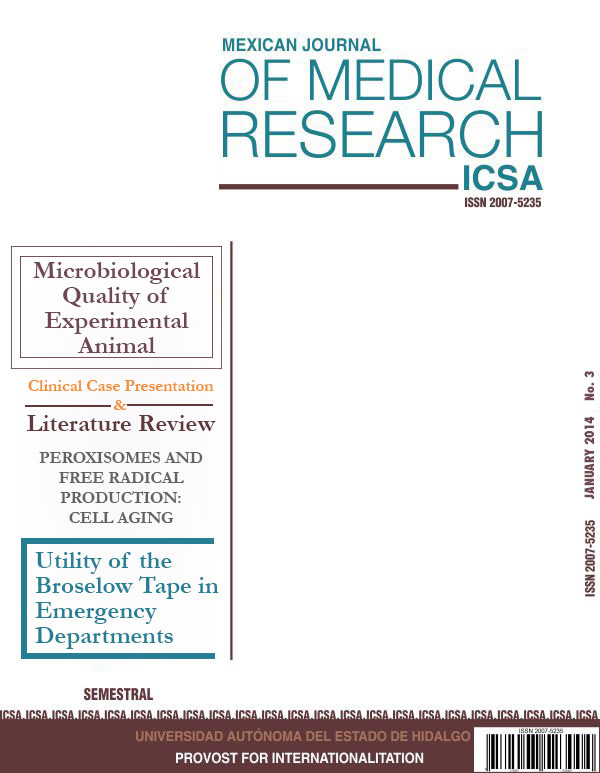Peroxisomes and free radical production: cell aging
DOI:
https://doi.org/10.29057/mjmr.v2i3.1799Keywords:
ROS, Aging, peroxisomes.Abstract
Peroxisomes are cellular organelles present in the eukaryotic cells that are responsible for detoxification processes such as oxidation of fatty acids, biosynthesis of glycerolipids and isoprenoids, among others. Due to the number of functions which they carry out, they are conditioned to an elevated production of free radicals (FR), for which they have a sophisticated antioxidant system consisting of enzymes that can neutralize free radical molecules. The importance of peroxisomes in the development of age-related diseases such as diabetes, cancer and cardiovascular disease has been reported recently. In this paper, we review briefly these organelles, treating aspects such as their evolution, functions and the role they play in oxidative stress processes associated with aging.
Downloads
Publication Facts
Reviewer profiles N/A
Author statements
- Academic society
- N/A
- Publisher
- Universidad Autónoma del Estado de Hidalgo
References
2. Michels PA, Bringaud F, Herman M, Hannaert V. Metabolic functions of glycosomes in trypanosomatids. Biochim. Biophys. Acta 1763. 2006; 1463–1477.
3. Gabaldón T. Peroxisome diversity and evolution. Phil. Trans. R. Soc. B. 2010; 365: 765–773.
4. Agne B, Meindl NM, Niederhoff K, Einwachter H, Rehling P, Sickmann A, Meyer H. E, Girzalsky W, Kunau WH. Pex8p: an intraperoxisomal organizer of the peroxisomal import machinery. Mol. Cell. 2003; 11: 635–646.
5. Grou CP, Carvalho AF, Pinto MP, Alencastre IS, Rodrigues TA, Freitas MO, Francisco T, Sa-Miranda C, Azevedo JE. The peroxisomal protein import machinery—a case report of transient ubiquitination with a new flavor. Cell Mol. Life Sci. 2009; 66: 254–262.
6. Delille HK, Alves R, Schrader M. Biogenesis of peroxisomes and mitochondria: linked by division. Histochem. Cell Biol. 2009; 131: 441–446.
7. Bottelbergs A, Verheijden S, Van Veldhoven PP, Just W, Devos R, Baes M. Peroxisome deficiency but not the defect in ether lipid synthesis causes activation of the innate immune system and axonal loss in the central nervous system. J Neuroinflammation. 2012; 29:9(1):61.
8. Tabak HF, Murk JL, Braakman I, Geuze HJ. Peroxisomes start their life in the endoplasmic reticulum. Traffic. 2003; 4: 512–518.
9. Gabaldón T, Snel B, van Zimmeren F, Hemrika W, Tabak H, Huynen MA. Origin and evolution of the peroxisomal proteome. Biol. Direct. 2006; 1- 8.
10. Birdsey GM, Lewin J, Cunningham AA, Bruford MW, Danpure CJ. Differential enzyme targeting as an evolutionary adaptation to herbivory in carnivora. Mol. Biol. Evol. 2004; 21, 632–646.
11. Camacho A, Mendoza JA. La naturaleza efímera de los radicales libres. Química y bioquímica de los radicales libres. En: Los antioxidantes y las enfermedades crónico degenerativas. 1era edición. Universidad Autónoma del Estado de Hidalgo 2009. Pachuca, Hgo., México. 27-76.
12. Wu D, Cedarbaum A. Alcohol, oxidative stress, and free radical damage. Mechanism of injury. Alcohol Res Health. 2003; 27: 277-284.
13. Del Río LA, Sandalio LM, Corpas FJ, Palma JM, Barroso JB. Reactive Oxygen Species and Reactive Nitrogen Species in Peroxisomes. Production, Scavenging, and Role in Cell Signaling. Plant Physiology. 2006; 141: 330–335.
14. Antonenkov VD, Grunau S, Ohlmeier S, Hiltunen JK. Peroxisomes are oxidative organelles. Antioxid Redox Signal. 2010; 13: 525–537.
15. Terlecky SR, Koepke JI, Walton PA. Peroxisomes and Aging. Biochim Biophys Acta. 2006; 1763(12): 1749–1754.
16. Kim HS, Song MC, Kwak IH, Park TJ, Lim IK. Constitutive induction of p-Erk1/2 accompanied by reduced activities of protein phosphatases 1 and 2A and MKP3 due to reactive oxygen species during cellular senescence. J Biol Chem. 2003; 278: 37497–37510.
17. Fialkow L, Wang Y, Downey GP. Reactive oxygen and nitrogen species as signaling molecules regulating neutrophil function. Free Radic Biol Med. 2007; 42: 153–164.
18. Ivashchenko O, Van Veldhoven PP, Brees C, Ho YS, Terlecky SR, Fransen M. Intraperoxisomal redox balance in mammalian cells: oxidative stress and interorganellar cross-talk. Mol Biol Cell. 2011; 22(9): 1440-51.
19. Dixit E et al. Peroxisomes are signaling platforms for antiviral innate immunity. Cell. 2010; 141: 668–681.
20. Koopman WJ, Nijtmans LG, Dieteren CE, Roestenberg P, Valsecchi F, Smeitink JA, Willems PH. Mammalian mitochondrial complex I: biogenesis, regulation, and reactive oxygen species generation. Antioxid Redox Signaling. 2010; 12: 1431–1470.
21. Malinouski M, Zhou Y, Belousov VV, Hatfield DL, Gladyshev VN. Hydrogen peroxide probes directed to different cellular compartments. PLoS One. 2011; 6(1):e14564.
22. Elsner M, Gehrmann W, Lenzen S. Peroxisome-generated hydrogen peroxide as important mediator of lipotoxicity in insulin-producing cells. Diabetes: 2011; 60(1): 200-8.
23. Chao C, Youssef J, Rezaiekhaleigh M, Birnbaum L, Badr M. Senescence-associated decline in hepatic peroxisomal activities corresponds with diminished levels of retinoid X receptor alpha, but not peroxisome proliferator-activated receptor alpha. Mech Ageing Dev 2002; 123:1469–1476.
24. Legakis JE, Koepke JI, Jedeszko C, Barlaskar F, Terlecky LJ, Edwards HJ, Walton PA, Terlecky SR. Peroxisome senescence in human fibroblasts. Mol Biol Cell. 2002; 13: 4243–4255.
25. Góth L, Eaton JW. Hereditary catalase deficiencies and increased risk of diabetes. Lancet .2000; 356: 1820–1821.
26. Muller S, Weber A, Fritz R, Mu S, Rost D, Walczak H, Volkl A, Stremmel Sensitive and real-time determination of H2O2 release from intact peroxisomes Biochem. J. 2002; 363: 483-491.
27. Muller M. Cellular senescence: molecular mechanisms, in vivo significance, and redox considerations. Antioxid Redox Signaling. 2009; 11: 59–98.
28. Harano T, Nose S, Uezu R, Shimizu N, Fujiki Y. Hsp70 regulates the interaction between the peroxisome targeting signal type 1 (PTS1)-receptor Pex5p and PTS1. Biochem J. 2001; 357: 157–165.






















